|
In
depth information on how to grow
Philodendron
species, Click this Link
Within our collection we have many species of Philodendron.
If you are seeking other photos,
click this link
Philodendron williamsii
Hook. f.
We do not have this plant in
the Exotic Rainforest collection.

If the plant you believe is
Philodendron williamsii
doesn't look like this photo,
you likely have Philodendron stenolobum!
Read the text for a detailed explanation. So please, before you click
the "X" and ignore the information on this page, please read it! The
chances are high you will learn the plant you have always believed to be
Philodendron williamsii is something
else!
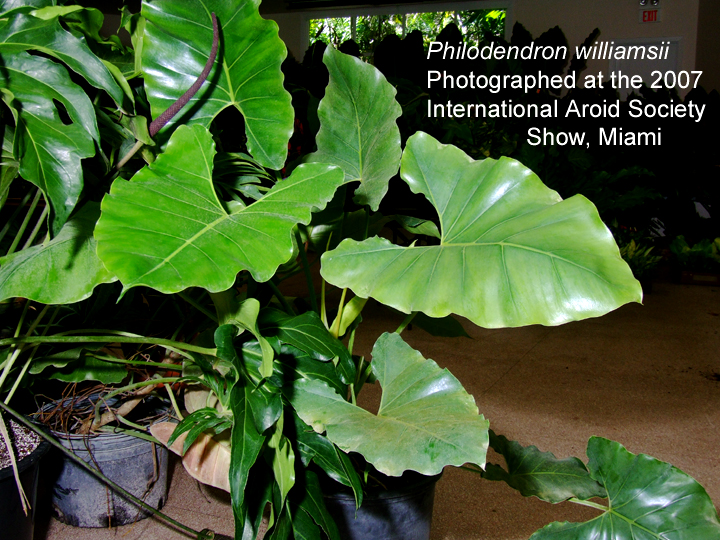
Philodendron williamsii
Hook. f.
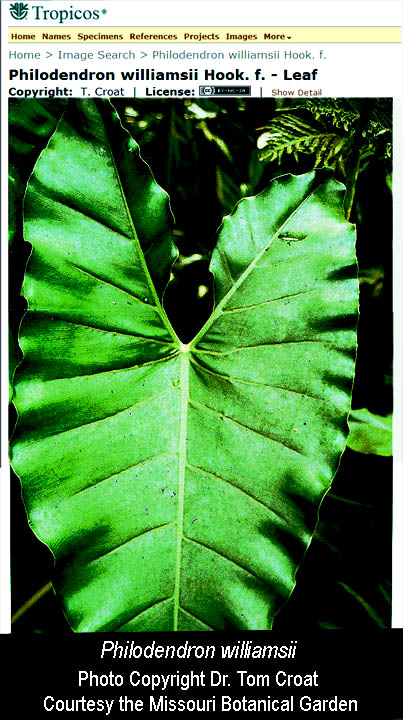 A member of
Philodendron section Meconostigma, Philodendron
williamsii is truly rare in both nature and collections.
The photo above is of a plant in the collection of rare plant
collector Ron Weeks in Miami, FL. This species has been the source of a
great deal of confusion among collectors. Little information is available on
Philodendron williamsii either in botanical journals or via
the internet. The Missouri Botanical Garden's TROPICOS website map
locator indicates the plant has been collected in areas of Central
America. However, the Royal Botanical Garden Kew indicates the
species was strictly collected in Brazil. A member of
Philodendron section Meconostigma, Philodendron
williamsii is truly rare in both nature and collections.
The photo above is of a plant in the collection of rare plant
collector Ron Weeks in Miami, FL. This species has been the source of a
great deal of confusion among collectors. Little information is available on
Philodendron williamsii either in botanical journals or via
the internet. The Missouri Botanical Garden's TROPICOS website map
locator indicates the plant has been collected in areas of Central
America. However, the Royal Botanical Garden Kew indicates the
species was strictly collected in Brazil.
Here is an
explanation for the confusion written by noted aroid expert Julius
Boos,
"The two
species in question are very different, and occur naturally in
different areas of Brazil, P. stenolobum in South-Central Brazil, P.
williamsii further North-East in the tiny remnants of what used to
be the Brazilian Atlantic Coast rain forest, now almost gone,
bulldozed for cow pastures. They differ from each other in
important sexual features, this can be read in Dr. Gonçalves paper
in Aroideana. If you are interested in seeing a fantastic plant of
true P. williamsii visit Silver Krome Nursery in Miami, FL and if
Dennis Rotalante and his son Big Bill are able they can show
you their plant of this, one of only five specimens in Florida
(three in the Miami area, two, one misidentified as P. stenolobum,
in W. Florida. I believe there are only seven specimens in the
entire United States. They all came from Missouri Botanical Garden,
grown from wild-collected seed in Brazil and were harvested by Dr.
Simon Mayo of Kew Gardens in London. P. williamsii is now so
scarce in the wild that Dr. Gonçalves in his search for wild
specimens, while doing research for what was his description of P.
stenolobum, came across only one plant growing high in a tree in a
tiny remnant of the original forest. Graf's books
Exotica and Tropica are now way out of date but there are still some
'old school' collectors who believe them just like, believe it or
not, there is still a "Flat Earth Society", with members who swear
that our Earth is flat."
The leaf blades of
Philodendron williamsii are moderately coriaceous (leathery)
and according to Aroids, Plants of the Arum Family
can grow to 35 inches (90cm). However, the published
scientific description of Philodendron williamsii indicates the blades are only 30 to
76cm (1 foot to 2.5 feet) in length. I fear much published
non-scientific information, including that otherwise excellent text, may be actually describing Philodendron stenolobum
Gonçalves in error since information simply does not match the scientific description
of Philodendron williamsii. Philodendron stenolobum
is also a member of Philodendron section Meconostigma but the
two species are not interchangeable and are not from the same states
in Brazil. You will soon read a note
from the botanist who wrote the description of Philodendron
stenolobum which echos that fear.
In
Brazil, P. williamsii is found on the Atlantic coast while
Philodendron stenolobum is found only in the south central portion of
Brazil.
Aroid expert
Leland Miyano
explains,
"Dr. Simon
Mayo of KEW wrote the revision of the subgenus, Meconostigma in
1991. He did not split Philodendron stenolobum from Philodendron
williamsii...but he did note the differences and thought that two
taxa may be involved between the Espirito Santo state plants and the
Bahia state populations. He did not have the fertile material of
Philodendron stenolobum to compare."
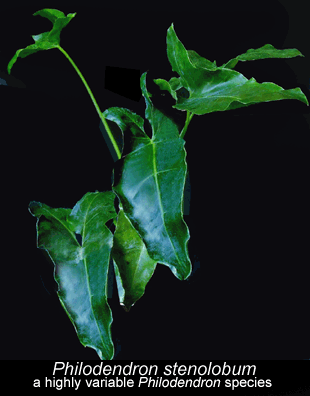
At one time this species
was popularly thought to be grown by collectors but the plant they were
collecting is truly Philodendron stenolobum
Gonçalves
(see the description of that plant on this website).
The majority of plants offered for sale on the internet and called "Philodendron
williamsii" are not the true species but are instead Philodendron
stenolobum. P.
stenolobum is highly variable with more than one blade form and as a result collectors often
believe they have a very rare Philodendron williamsii in error. I
include myself in that group! I now own two specimens of
Philodendron stenolobum and until I began to research this
article with the help of expert Julius Boos I was certain both were
Philodendron williamsii.
P. stenolobum often has several different blade shapes. The two species are vaguely similar but most collectors
appear to believe P. stenolobum is the more
beautiful of the two. With careful examination the differences
can easily be seen. As a result, Philodendron williamsii
is rarely seen in collections. Still, you can
find many websites today identifying photographs of Philodendron
stenolobum incorrectly as Philodendron williamsii.
This link better explains natural variation which is a known
scientific subject:
Click here.
The
problem appears to have been caused by a variety of
horticulturalists and/or collectors who have failed to read the
scientific material describing both species. All too often horticulture differs from
botanical science and grants plants names that are not
scientifically accurate. In a personal letter to aroid
authority and expert Julius Boos, Brazil's top aroid botanist, Dr. Eduardo Gonçalves, made this observation,
"All
horticultural "P. williamsii" is now P. stenolobum. The real P.
williamsii is a completely different species, occurring in coastal
Bahia state and is rather rare. I don´t have it in cultivation and I
have never seen a living specimen in any collection I have visited. It looks like a P. speciosum (or like a huge P. corcovadense),
but is somewhat smaller in overall dimensions. I have collected it
twice in southern Bahia and I have seen a few more collections in
Herbarium. Philodendron stenolobum is only known from Espirito Santo
state and is much more common, being found by me in many different
localities. I don´t know when or where the confusion began, but P. stenolobum is called P. williamsii in lots of old publications
(including Graf´s Exotica). Simon in his revision of Philodendron
Meconostigma included P. stenolobum specimens in P. williamsii,
probably because he hadn´t enough good material of P. stenolobum to
be sure it was a different thing."
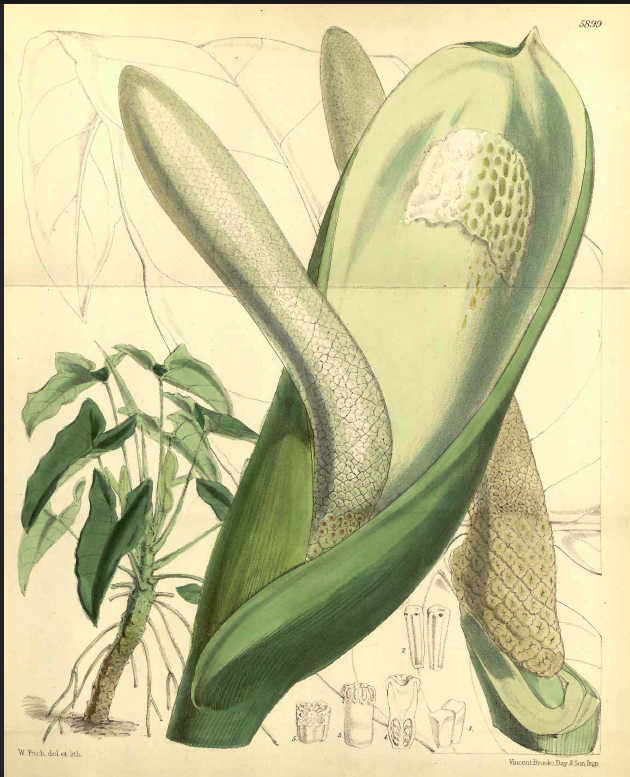 Leland
Miyano who lives in Hawaii explains in even more detail. Leland has
lived and worked in Brazil alongside world renowned plant collector
Roberto Burle-Marx, Leland wrote in April, 2008,
"I
think that a lot of the confusion of
Philodendron williamsii, Philodendron spiritus-sancti, and
Philodendron stenolobum arise out the geography of
the area. Leland
Miyano who lives in Hawaii explains in even more detail. Leland has
lived and worked in Brazil alongside world renowned plant collector
Roberto Burle-Marx, Leland wrote in April, 2008,
"I
think that a lot of the confusion of
Philodendron williamsii, Philodendron spiritus-sancti, and
Philodendron stenolobum arise out the geography of
the area.
First of all, the name P. spiritus-sancti is derived
from the state of Espirito Santo, Brazil. Philodendron
spiritus-sancti is found near the town of Domingo Martins, Espirito
Santo state, Brazil. North of this town is the town of Santa
Leopoldina...a source of much confusion for a host of Philodendron
horticultural names. Further to the north is the town
of Santa Theresa....which is where the Augusto Ruschi Museum is. I
do not know the exact limits of the distribution of Philodendron
stenolobum , but we found it as we approached the region of the Rio Doce, in Espirito Santo state.
At the time, Philodendron
stenolobum was thought to be Philodendron williamsii because Simon
Mayo was actively working on
Meconostigma. I met him at Roberto Burle-Marx's sitio before he
published his treatment. In fairness to Simon Mayo, he had to work
with only a few specimens and incomplete material. He also thought
that the Espirito Santo state plants differed from the Brazilian
state of Bahia population...which is where the true Philodendron
williamsii is found. Bahia
state is to the north of Espirito Santo state. Northern
Espirito Santo and Southern Bahia have a really interesting floral
link. To add to the confusion, Philodendron stenolobum has been
referred in the horticulture trade as Philodendron 'Espirito
Santo'."
The drawing
to the right of the inflorescence of Philodendron williamsii is from
Volume 28 of Curtis's Botanical Magazine, Royal Botanic Garden Kew
If after reading the
explanations from Dr. Gonçalves and Leland you
still believe you have Philodendron williamsii, please
understand it is highly
unlikely you actually have the species in a private collection.
As reported by Leland, Philodendron specialist Simon
Mayo of the Royal Botanical Garden Kew is reported to have collected
Philodendron williamsii in
Brazil in Bahia, Uruçuca, and Distrito de Serra Grande.
And if you are
still convinced you possess the species as I was prior to spending a
great deal of time exchanging mail with Julius Boos, you can use
Julius'
expert information to easily discern the difference. According to Julius, a fool proof
method to determine which species you possess is to look for the
super-wide sinus with the near naked to the top vein of the rear
lobes of Philodendron williamsii. If you are unaware of
what a "sinus" is on a plant it is simply the area between the
lobes. On Philodendron williamsii these are quite
different from those of any form of Philodendron stenolobum.
After suggesting growers compare the two species side by side,
Julius wrote, "All
these leaf variations in P. stenolobum still possess a much narrower
sinus with only a short area of naked veins near the very base of
the sinus".
In
an effort to get the best information possible I
requested additional notes from Dr. Gonçalves (gon-ZAL-ves) of the
Universidade Catolica de Brasilia who is the most noted Brazilian
botanical authority on Philodendron sp. and aroid species.
Dr.
Gonçalves published the scientific
work on Philodendron stenolobum and responded in a personal
email: "Philodendron
williamsii is a hemiepiphyte and usually occurs very high at the
canopy, sometimes above 30m above the soil. It is one of the
rarest self heading Philos and I could collect it only a few times."
A
hemiepiphyte (hem-a-EPA-fit) is a species that may begin life either on the side of
a tree as an epiphyte and extend its roots to the ground or it may
begin life in the soil and grow up the tree to become epiphytic.
In Dr. Gonçalves' response it becomes obvious this one can be quite a
climber able to reach almost 100 feet into the canopy!
However, recent information indicates this plant is not likely to
climb to that height. Instead, it begins life up in the
branches as a seed and drops roots all the way to the ground. A "self
heading" species is one that is capable of standing upright alone
without support. Dr. Gonçalves' email further indicated this
species may be prone to rot.
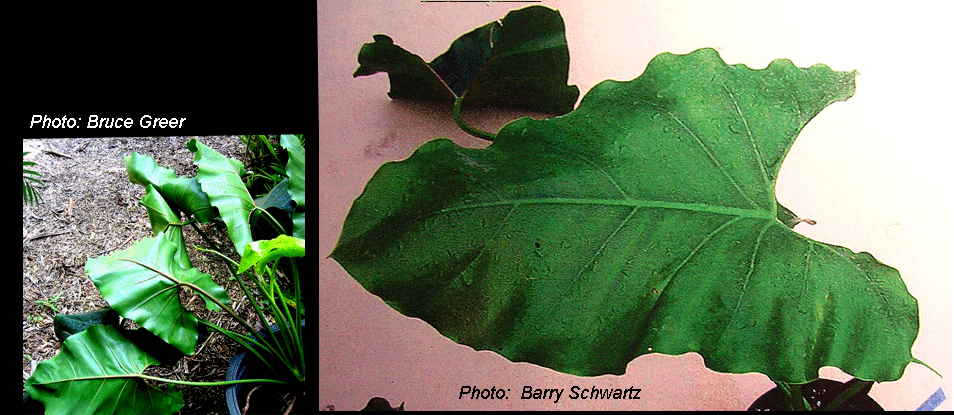
Julius also provided the following
information for those truly serious about determining exactly which
species they possess,
"In determining if a plant is
P. williamsii or P. stenolobum, the following will be of help.
The leaf ratios (length to width) are: P. williamsii, 1-1.5, P.
stenolobum: 2.1-3.3. On leaf blades of P. williamsii the veins
of the hind or posterior lobes of the leaf blade at the sinus (the
"Y" at the top of the main lobe where the petiole attaches to the
leaf blade) are around 50% 'naked' on their top sides, with only a
small portion near the very tops of the posterior lobes with tissue
on both sides of these veins. (see photos and the illustration of
Hooker`s type.). In P. stenolobum there is only a short naked
portion on the veins near the base of the "Y", less than 25 % of
the length of these veins. (See photos and illustrations in Dr.
Goncalves' paper.) As in all botanical specimens, the final
proof is in the fertile material, and though most hobby-type growers
may only infrequently have blooms on their plants, the following
information is in fact the most important aspects of determining the
differences between these two very different species. In P.
williamsii, the gynoecium is 'barrel-shaped', and has up to 12
chambers or locules. (see Hooker`s illustration) In P.
stenolobum, the gynoecium is 'flask-shaped and contains only 7-8
chambers or locules. (see Dr. Goncalves' illustration)."
But keep in mind, due to the
extreme rarity of the actual species, it is highly unlikely you will
find Philodendron williamsii, even by accident, in a private
collection. Very few accredited botanical institutions
actually possess a true specimen. Almost all plants sold with
this name are actually a form of Philodendron stenolobum.
(see the description of
Philodendron stenolobum here)
Philodendron species,
and especially hybrid forms, are
known to be highly variable and not every leaf of every specimen
will always appear the same. This link explains in greater
detail the scientific principle of natural variation and
morphogenesis.
Click
here.
From Curtis's Botanical Garden,
Volume 28
TAB. 5899.
PHILODENDRON
WILLIAMSII
Native of Brazil.
Nat. Ord. AROIDE^E.•Tribe PHILODENDREIE.
Genus PHILODENDRON, Schott ;
(Prod. Syst. Aroid., p. 219).
PHILODENDRON WiUiamsii ;
trunco crasso suberecto cicatricato, foliis longe
petiolatis 2-3-pedalibus ¡sagittatis acutis lobis posticis
oblongoovatis obtusis, costis venisque subtus lu ride
rubro-purpureis, costis loborum posticorum basin versus sinus
marginalibus, venis patentibus, venulis numerosissimis, petiolo
elongato terete lsevi supra canliculato, pedunculis solitariis
axillaribus spatha viridi intus
flavescente pedali oblongo-cymbiibrmi basi sub•quali attenuate,
spadice cylindrico spatbam subsequante obtuso basi dorso spath•
brcviteradnato, infra medium paulo constricto, parte supra
constrictionem inclinato lateraliter protruso, antheris
elongato-cuneatis apice truncato trapaezoideo, poris minutis,
ovariis 4-gonis multilocellatis, vértice late intruso, stigmatibus
numerosis adnatis breviter decurrentibus, ovulis in loculis
numerosis.
This noble Aroid
has been for years a well known ornament of the aquarium near the
Palm House at Kew, growing in a pot the base of which is immersed,
and forming a crown of bright green foliage, six feet in diameter,
and four to five feet in height. It was sent to Kew by Mr. Williams,
of Bahia, many years ago, flowers annually, and
would have been published in this
Magazine ere this, but for the difficulty of naming the plants of
this genus, which embraces upwards of one hundred and fifty species,
many of them most imperfectly described. As however it agrees with
none of those contained in Schotte excellent monograph (1800), has
not since been figured in any publication accessible to me, and has
not been recognised by the many continental botanists and
horticulturists who have seen it at Kew, I am emboldened to describe
it as new, and give it the name
MAT 1ST, 1871.
Aroid Pollination!
As
it occurs in nature and by any horticulturist
If you are seeking information on
other rare species, click on "Aroids and other genera in the Collection" at the top
and look for the

Want to learn more
about aroids?
Join the
International Aroid Society:
http://www.exoticrainforest.com/Join%20IAS.html
|
![]()

 A member of
Philodendron section Meconostigma, Philodendron
williamsii is truly rare in both nature and collections.
The photo above is of a plant in the collection of rare plant
collector Ron Weeks in Miami, FL. This species has been the source of a
great deal of confusion among collectors. Little information is available on
Philodendron williamsii either in botanical journals or via
the internet. The Missouri Botanical Garden's TROPICOS website map
locator indicates the plant has been collected in areas of Central
America. However, the Royal Botanical Garden Kew indicates the
species was strictly collected in Brazil.
A member of
Philodendron section Meconostigma, Philodendron
williamsii is truly rare in both nature and collections.
The photo above is of a plant in the collection of rare plant
collector Ron Weeks in Miami, FL. This species has been the source of a
great deal of confusion among collectors. Little information is available on
Philodendron williamsii either in botanical journals or via
the internet. The Missouri Botanical Garden's TROPICOS website map
locator indicates the plant has been collected in areas of Central
America. However, the Royal Botanical Garden Kew indicates the
species was strictly collected in Brazil. 
 Leland
Miyano who lives in Hawaii explains in even more detail. Leland has
lived and worked in Brazil alongside world renowned plant collector
Roberto Burle-Marx, Leland wrote in April, 2008,
"I
think that a lot of the confusion of
Philodendron williamsii, Philodendron spiritus-sancti, and
Philodendron stenolobum arise out the geography of
the area.
Leland
Miyano who lives in Hawaii explains in even more detail. Leland has
lived and worked in Brazil alongside world renowned plant collector
Roberto Burle-Marx, Leland wrote in April, 2008,
"I
think that a lot of the confusion of
Philodendron williamsii, Philodendron spiritus-sancti, and
Philodendron stenolobum arise out the geography of
the area. 